Delicate, aromatic Veles grape variety from Ukrainian breeders
Hybrid Veles is a striking example of successful breeding work. The grapes are in great demand on the market and are of interest to winegrowers. This is facilitated by the attractive amber-pink color of the berries, large clusters, balanced sugar and acid content and a pleasant nutmeg aftertaste. In this article we have collected information about growing a hybrid and its distinctive characteristics.
The history of the creation of the Veles hybrid
The authorship of the grape hybrid called Veles belongs to the Ukrainian breeder from Zaporozhye V.V. Zagorulko. The culture belongs to the dessert type. First cuttings went on sale in 2009, and in 2010 the hybrid was presented at the international competition “Golden Bunch of Grapes” in Crimea. There he won two gold medals in the categories “People's Tasting Commission” and “Professional Tasting Commission”. Large clusters of purple seedless berries and a nutmeg aroma immediately attracted attention.
To obtain the hybrid, the breeder used seedless Rusbol bred at the Novocherkassk Research Institute of Vital and Vital Plants named after. Ya. I. Potapenko and his own hybrid Sofia. The father's form was the seedless Kishmish Radiant. The main goal of the breeder was to transfer the valuable trait of seedlessness. As a result, he managed to create one of the best dessert hybrids with excellent taste and adaptability to growth even outside the parent region.Veles is successfully cultivated in Ukraine, Russia and Belarus.
The culture is not included in the State Register of the Russian Federation because it has not yet passed all the tests.
Interesting! Veles is a Slavic battle of fertility, wealth, wisdom and luck, second in importance after Perun.
Characteristics and description of the plant
The Veles hybrid bushes are distinguished by their high growth vigor. The crowns of young shoots are green with a bronze tint.
The leaves are large, round in shape, medium wide, three-lobed, wrinkled, with deep side notches, open in type. Along the edge of the leaf are dome-shaped wide teeth.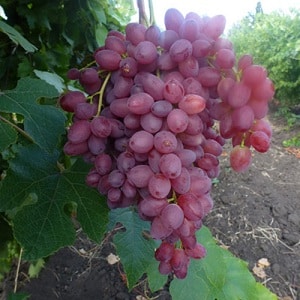
The flowers are bisexual and capable of self-fertilization. However, when using hand pollination, yields increase significantly.
The hybrid is not prone to peas. The clusters are large, cylindrical or conical in shape, loose or medium-dense, 20-30 cm long. Maximum weight - 3 kg, average - 800-1550 g. The berries do not deform or rot due to their free arrangement on the cluster; in conditions of excessive humidity they crack slightly.
The comb is medium, the stems of the fruit are long, light green, dense. The oval-shaped berries, weighing 5-7 g, remain on the bush for a long time, do not fall off for up to 1.5 months and gradually turn into raisins.
The skin is thin, almost invisible when consumed, golden-pink in color, with a slight waxy coating. Color intensity varies depending on ripeness and light level.
The pulp is dense, tender, juicy. The taste is balanced, the ratio of acid and sugar is harmonious, the aftertaste is pronounced nutmeg. Sugar content of berries of removable ripeness is 16.5-19 g/100 ml, acidity is 6-7 g/l.
The bones are absent or presented in the form of small rudiments.This increases the tasting rating of Veles.
The hybrid belongs to the group of grapes with very early ripening. The harvest is harvested 90-105 days after the buds appear. The yield of Veles is average, but stable - 10-15 kg per mature vine.
In the photo - Veles grapes.
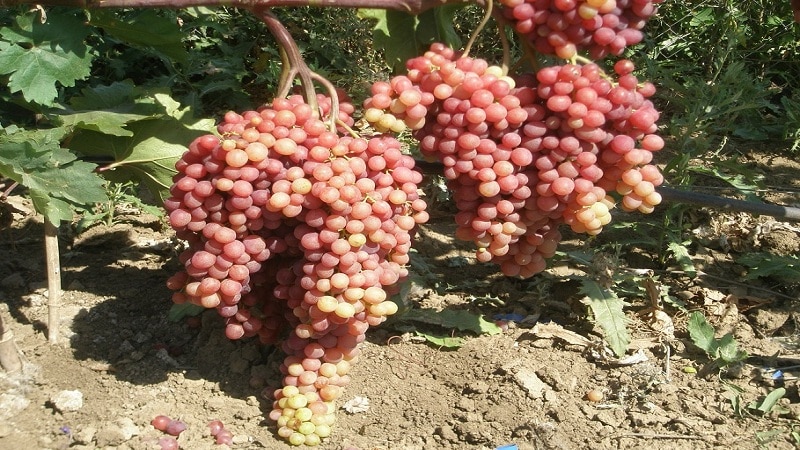
Sustainability
The frost resistance of the hybrid is average - the vine can withstand frosts down to -21°C. This indicator significantly exceeds the resistance of other representatives of the raisin grape.
Before the onset of cold weather, the shoots have time to grow stronger along their entire length. The hybrid has a high fruiting potential. 2-3 inflorescences are formed on each shoot.
The berries are rarely damaged by wasps, despite their thin skin. Bunch leaf rollers are indifferent to culture. The grapes are resistant to fungal diseases - mildew (downy mildew) and oidium (powdery mildew).
Advantages and disadvantages
Advantages of a hybrid:
- attractive appearance;
- pleasant balanced taste and nutmeg aftertaste;
- resistance to peas and deformation of berries;
- stable yield;
- resistance to insect attacks and fungi;
- high level of transportability;
- ease of care.
Flaws:
- average frost resistance;
- cracking of berries at high humidity.
Features of cultivation
To obtain a rich harvest, it is recommended to follow the rules of planting and caring for the vine.
Landing dates and rules
Hybrid Veles is propagated in two ways: vaccination on rootstock and cuttings.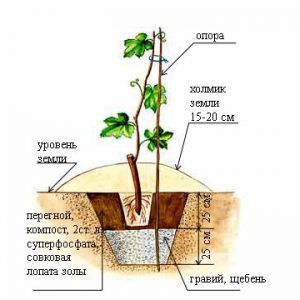
The best time to graft grapes is from March to May, depending on the region. The new bush begins to bear fruit early after grafting onto the old rootstock. In the fall, cuttings with 2-3 eyes are cut, the tips are dipped in liquid paraffin, wrapped in film and placed in the refrigerator until spring.
Rootstock bush in spring cut, leave a stump, the cut is leveled and cleaned. The cuttings are cut with a wedge and soaked in water for 10-12 hours. Next, they place it in a split in the center of the stump, tighten the attachment point with cloth and apply a layer of clay.
The second method is planting seedlings. Healthy cuttings with 4-5 buds are placed in a container with water in early February or planted in moist soil so that they take root.
Veles is planted in nutritious, air- and moisture-permeable soil, ideally in black soil. The landing site should be warmed by the sun.
Important! An area with high groundwater levels and swampy areas are not suitable for grapes.
Landing is carried out in the direction from south to north. The hybrid bushes are large and require a lot of space for growth and development. When planting, maintain a distance of 1.5-2 m. The distance from trees and buildings is 3-4 m.
The pit is prepared in 2-3 weeks: 80 cm deep, 80 cm in diameter. The bottom is lined with a mixture of earth, humus and phosphorus-potassium fertilizers. 3-4 cm of soil without impurities is poured on top. The seedlings are dipped into the growth stimulator "Gumat". The concentration of the solution is 0.5 mg/l.
Planting is done carefully so as not to damage the delicate root shoots. The rhizome is completely covered with earth, the surface is compacted, watered with 20-30 liters of water and mulched with sawdust.
Features of care

Veles prefers to grow on soil with moderate humidity, so watering is done regularly after the top layer has dried. The need for moisture increases during the periods of leaf emergence, flowering and cluster formation, and after harvest. Installing a drip irrigation system helps make vineyard maintenance easier.
Mulching retains soil moisture and reduces the amount of watering.Sawdust, peat, straw or humus are used as mulch, which also serves as fertilizer.
The vine is formed into a fan with 4 sleeves. To maintain shape, perform regular spring pruning - 6-8 eyes are left on each vine.
The hybrid is characterized by the ability to form a large number of stepsons. When growing grapes in the middle zone, they are removed, but in the south they are retained, since a second wave of harvest is formed on them. Under favorable conditions, the bunches ripen in October, but the berries are slightly smaller in size and contain more acid.
Reference. The supports of the bushes are made in the form of trellises, single supports or arches.
In autumn the vine is pruned, remove unripe parts and excess shoots. In regions with cold winters it shelter for the winter, pre-tied in bunches. The vine is laid on the ground and cover with dry leaves or straw, thick film or agrofibre.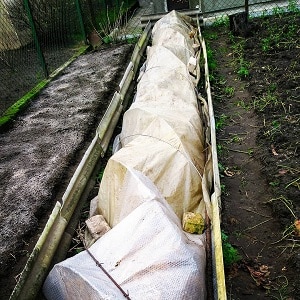
For normal development, grapes are fed with potassium, phosphorus, iron, zinc and boron (for example, 10 g of ammonium nitrate per 1 m²). It is important to fertilize after flowering, otherwise the plant will begin to actively gain green mass. The vine receives organic compounds from mulch during watering. At the beginning of fruit ripening, add 20 g of Nitrophoska, 30 g of superphosphate, 50 g of ash per 10 liters of water (consumption per 1 m²).
The formation of bushes involves controlling the number of eyes during spring pruning. No more than 35-40 pieces are left on one bush. Barren and weak shoots are removed, and one cluster is left on the fruitful ones. These procedures relieve the vine and ensure stable fruiting.
Possible problems, diseases, pests
Preventive measures reduce the likelihood of infection by pathogenic fungi, bacteria and viruses. Agrotechnical practices: timely pruning, pinching, tying up shoots, removing weeds and maintaining loose soil. In this case, the leaves around the brushes are removed in a normal manner, since the golden-pink hue of the skin appears only in partial shade.
Despite the fact that Veles is immune to fungal infections, preventive processing fungicides are necessary. A solution of Bordeaux mixture and colloidal sulfur is effective.
Advice. To protect the bunches from birds, use fabric bags or nets.
Features of cultivation depending on the region
The crop needs +2100°C total active temperatures to achieve full ripeness. This quality allows it to be grown in the northern regions, provided that the vine is covered for the winter. In the south, Veles manages to produce a second harvest on his stepsons.
In regions with cold winters, the hybrid is cultivated as a semi-covering and covering crop. The fan-shaped and squat shape allows you to remove bunches and create thermal insulation in regions with frosts from -21°C.
Semi-covering method maintaining the bush on a trunk protects the reserve lightweight part from severe frosts. If the main part dies, the bush is restored from the existing reserve. This method is practiced in areas where the air temperature in winter rarely drops below -21°C.
Harvesting and application
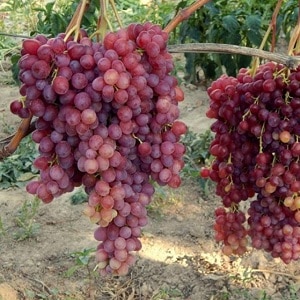
The harvest is harvested in late July and early August. The brushes are cut with pruning shears; they cannot be broken off. The second harvest ripens in October. The grapes can withstand transportation despite their thin skin. Brushes are placed in shallow wooden boxes.
The harvest is stored in the cellar for up to 3 months.The brushes are hung on stretched twines for better preservation. Grapes are used fresh and for processing into jam, raisins, wine, compote
Reviews
Reviews from winegrowers about the Veles hybrid are only positive.
Ivan, Krasnodar: “I planted this variety three years ago. I heard about it from my Ukrainian relatives and was eager to raise it in my dacha. The grapes are beyond praise; I picked the first bunch a year later. Another year later I received a large harvest. The clusters are large and weighty. Mine reached 2 kg. The berries are dense, do not crack, sweet, nutmeg, there were seeds, but small, imperceptible.”
Zoya, Bryansk: “Veles grapes have been growing for me for 5 years. It bears fruit consistently, the yield is average, but I grow it solely for its taste and appearance. The clusters are large, the berries do not rot, and are evenly colored as they ripen. The year before last it was hot and seeds appeared in the berries. Last summer was mild and there were no seeds. Caring for bushes is standard - pruning, fertilizing, watering.”
Conclusion
Hybrid Veles is a product of the breeding work of V.V. Zagorulko. The culture appeared relatively recently, but managed to gain popularity among amateur winegrowers.
The grapes have an attractive appearance, the berries have a balanced taste. The plant is characterized by stable fruiting, resistance to insects and fungal infections. There are no difficulties in care. Agricultural technology involves moderate watering, fertilizing, pruning, staking the vines, and sheltering for the winter in regions with cold climates.